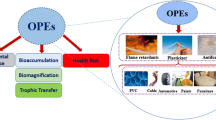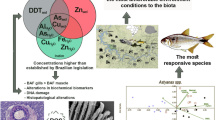Abstract
Background, aim and scope
Polychlorinated biphenyls (PCB) and dichlorodiphenyltrichloroethane (DDT) concentrations were determined in the liver of two deep sea fish species, Mediterranean slimehead and blackfin sorcerer, from the Adriatic Sea (southeastern Mediterranean Sea).
Results and discussion
The examination of congener profiles showed that hexachlorinated molecules were dominant (hexa-CBs, 55.3–56.2%), followed by penta-CBs (21.5–21.8%) and hepta-PCB 180 (14.9–16.0%). PCB 138, 153 and 180 were the prominent congeners accounting for 69.3% of the total PCBs. Among the compounds of DDT, p,p′-DDE was the most dominant molecule (Mediterranean slimehead, 86.6%; blackfin sorcerer, 92.8%), demonstrating the old age of these compounds in the environment. In both species, PCB contents were higher than those of DDTs. Contaminant load was higher in Mediterranean slimehead (PCBs, 1,086 ng g−1 lipid weight; DDTs, 799 ng g−1 lipid weight) than in blackfin sorcerer (PCBs, 561 ng g−1 lipid weight; DDTs, 224 ng g−1 lipid weight).
Conclusion
The high ratios ΣPCBs/ΣDDTs indicated predominantly industrial versus agrarian activities in the area. Dioxins toxic equivalent (TEQ) concentrations (8.1–18.7 pg TEQ per gram wet weight) reached those encountered in marine organisms at higher levels in the trophic chain, revealing the onerous status of contamination by PCBs in Mediterranean deep sea biota.



Similar content being viewed by others
References
Aguilar A, Borrell A, Reijnders PJH (2002) Geographical and temporal variation in levels of organochlorine contaminants in marine mammals. Mar Environ Res 53:425–452
Ballschmiter KH, Froescheis O, Jarman WM, Caillet G (1997) Contamination of the deep-sea. Mar Pollut Bull 34:288–289
Berg V, Ugland KI, Hareide NR, Aspholm PE, Polder A, Skaare JU (1997) Organochlorine contamination in deep-sea fish from the Davis Strait. Mar Environ Res 44:135–148
Berg V, Polder A, Skaare JU (1998) Organochlorines in deep-sea fish from the Nordfjord. Chemosphere 38:275–282
Bidleman TF, Patton GW, Walla MD, Hargrave BT, Vass WP, Erickson PE, Fowler BR, Scott V, Gregor DJ (1989) Toxaphene and other organochlorines in Arctic ocean fauna: evidence for atmospheric delivery. J Mar Res 39:443–464
Breivik K, Sweetman A, Pacyna JM, Jones KC (2002) Towards a global historical emission inventory for selected PCB congeners—a mass balance approach: emission. Sci Total Environ 290:199–224
Corsolini S, Aurigi S, Focardi S (2000) Presence of polychlorobiphenyls (PCBs) and coplanar congeners in the tissues of the Mediterranean loggerhead turtle Caretta caretta. Mar Pollut Bull 40:952–960
Covaci A, Losada S, Roosens L, Vetter W, Santos FJ, Neels H, Storelli A, Storelli MM (2008) Anthropogenic and naturally-occurring organobrominated compounds in two deep-sea fish species from the Mediterranean Sea. Environ Sci Technol 42:8654–8660
de Brito APX, Takahashi S, Ueno D, Iwata H, Tanabe S, Kubudera T (2002a) Organochlorine and butyltin residues in deep-sea organisms collected from the western North Pacific off-Tohoku Japan. Mar Pollut Bull 45:348–361
de Brito APX, Ueno D, Takahashi S, Tanabe S (2002b) Contamination by organochlorine compounds in walleye pollock (Theragra chalcogramma) from the Bering Sea, Gulf of Alaska and the Japan Sea, Japan. Mar Pollut Bull 44:164–177
de Brito APX, Ueno D, Takahashi S, Tanabe S (2002c) Organochlorine and butyltin residues in walleye pollock (Theragra chalcogramma) from the Bering Sea, Gulf of Alaska and the Japan Sea. Chemosphere 46:401–411
Erney DR (1983) Rapid screening procedures for pesticides and polychlorinate biphenyls in fish: colloborative study. J Assoc Off Anal Chem 66:969–973
FAO (1987) Fiches FAO d’Identification des Especes pour les Besoins de la Peche. Mediterranee et Mer Noir. Zone de peche 37. Revision 1, vol 2, pp 763–1529
Frignani M, Bellucci LG, Carraro C, Raccanelli S (2001) Polychlorinated biphenyls in sediments of the Venice Lagoon. Chemosphere 43:567–575
Frignani M, Bellocci LG, Carraro C, Fagotto M (2004) Accumulation of polychlorinated biphenyls in sediments of the Venice Lagoon and the industrial area of Porto Marghera. Chemosphere 54:1563–1572
Gordon JDM, Merrett NR, Haedrich RL (1995) Environmental and biological aspects of slope dwelling fishes of the North Atlantic. In: Hopper AG (ed) Deep water fisheries of the North Atlantic oceanic slope. Proceedings of the NATO Advanced Research, March 1994. Kluwer, The Netherlands, pp 1–26
Hargrave BT, Harding GC, Vass WP, Erickson PE, Fowler BR, Scott V (1992) Organochlorine pesticides and polychlorinated biphenyls in the Arctic Ocean food web. Arch Environ Contam Toxicol 22:41–54
International Council for the Exploration of the Seas (ICES) (1992) A compilation of standards and guidance values for contaminants in fish, crustaceans and molluscs for the assessment of possible hazards to human health. Document JMG 17/3/10E
Kannan K, Corsolini S, Imagawa T, Focardi S, Giesy P (2002) Polychlorinated -naphthalenes, -biphenyls, -dibenzofurans and p,p′-DDE in bluefin tuna, swordfish, cormorants and barn swallows from Italy. Ambio 31:207–211
Lee JS, Tanabe S, Takemoto N, Kubodera T (1997) Organochlorine residues in deep-sea organisms from Suruga Bay, Japan. Mar Pollut Bull 34:250–258
Li YF, Macdonald RW (2005) Sources and pathway of selected organochlorine pesticides to the Arctic and the effect of pathway divergence on HCH trends in biota: a review. Sci Total Environ 342:87–106
Mormede S, Davies IM (2001) Polychlorobiphenyl and pesticide residues in monkfish Lophius piscatorius and black scabbard Aphanopus carbo from the Rockall Trough. ICES J Mar Sci 58:725–736
Mormede S, Davies IM (2003) Horizontal and vertical distribution of organic contaminants in deep-sea fish species. Chemosphere 50:563–574
Official Journal of the European Communities (1976) L 262 of 27 September 1976
Official Journal of the European Communities (1979) L 33 of 8 February 1979
Ramu K, Kajiwara N, Mochizuki H, Miyasaka H, Asante KA, Takahashi S, Ota S, Yeh HM, Nishida S, Tanabe S (2006) Occurrence of organochlorine pesticides, polychlorinated biphenyls and polybrominated diphenyl ethers in deep-sea fishes from the Sulu Sea. Mar Pollut Bull 52:1784–1832
Serrano R, Fernández M, Rabanal R, Hernández M, Gonzales MJ (2000) Congener-specific determination of polychlorinated biphenyls in shark and grouper livers from the Northwest African Atlantic Ocean. Arch Environ Contam Toxicol 38:217–224
Smith DG (1990) Nettastomatidae. In: Quero JC, Hureau JC, Karrer C, Post A, Saldanha L (eds) Check-list of the fishes of the eastern tropical Atlantic (CLOFETA), vol 1. JNICT, Lisbon; SEI; PARIS; and UNESCO, Paris, pp 172–175
Solé M, Porte C, Albaigés J (2001) Hydrocarbons, PCBs and DDT in the NW Mediterranean deep-sea fish Mora moro. Deep-Sea Res 48:495–513
Solé M, Hambach B, Cortijo V, Huertas D, Fernández P, Company JB (2009) Muscular and hepatic pollution biomarkers in the fishes Phycis blennoides and Micromesistius poutassou and the crustacean Aristeus antennatus in the Blanes Submarine Canyon (NW Mediterranean). Arch Environ Contam Toxicol 57:123–132
Solis-Weiss V, Aleffi F, Bettoso N, Rossin P, Orel G, Fonda-Umani S (2004) Effects of industrial and urban pollution on the benthic macrofauna in the Bay of Muggia (industrial port of Trieste, Italy). Sci Total Environ 328:247–263
Stergiou KI, Karpouzi VS (2002) Feeding habits and trophic levels of Mediterranean fish. Rev Fish Biol Fish 11:217–254
Storelli MM, Storelli A, D’Addabbo R, Barone G, Marcotrigiano GO (2004a) Polychlorinated biphenyl residues in deep-sea fish from Mediterranean Sea. Environ Int 30:343–349
Storelli MM, Storelli A, Barone G, Marcotrigiano GO (2004b) Polychlorinated biphenyl and organochlorine pesticide residues in Lophius budegassa from the Mediterranean Sea (Italy). Mar Pollut Bull 48:743–748
Storelli MM, Storelli A, Marcotrigiano GO (2005) Concentration and hazard assessment of polychlorinated biphenyls and organochlorine pesticides in shark liver from the Mediterranean Sea. Mar Pollut Bull 50:850–858
Storelli MM, Marcotrigiano GO (2006) Occurrence and accumulation of organochlorine contaminants in swordfish from Mediterranean Sea: a case study. Chemosphere 62:375–380
Storelli MM, Perrone VG, Marcotrigiano GO (2007a) Organochlorine contamination (PCBs and DDTs) in deep-sea fish from Mediterranean Sea. Mar Pollut Bull 54:1968–1971
Storelli MM, Barone G, Marcotrigiano GO (2007b) Polychlorinated biphenyls and other chlorinated organic contaminants in the tissues of Mediterranean loggerhead turtle Caretta caretta. Sci Total Environ 373:456–463
Storelli MM, Losada S, Marcotrigiano GO, Roosens L, Barone G, Neels H, Covaci A (2009) Polychlorinated biphenyl and organochlorine pesticide contamination signature in deep-sea fish from the Mediterranean Sea. Environ Res 109:851–856
Takahashi S, Hayashi S, Kasai R, Tanabe S, Kubodera T (2001) Contamination of deep-sea organisms from Tosa bay, Japan by organochlorine and butyltin compounds. Nat Sci Mus Monogr 20:364–380
Tanabe S, Kannan N, Wakimoto T, Tatsukawa R (1987) Method for the determination of three toxic non-orthochlorine substituted coplanar PCBs in environmental samples at part-per-trillion levels. Int J Environ Anal Chem 29:199–213
Tanabe S, Ramu K, Mochizuki H, Miyasaka H, Okuda N, Muraoka M, Kajiwara N, Takahashi S, Kubodera T (2005) Contamination and distribution of persistent organochlorine and organotin compounds in deep-sea organisms from East China Sea. Nat Sci Mus Monogr 29:453–476
UNEP (2002) Regionally based assessment of persistent toxic substances. Mediterranean Regional Report, UNEP, Switzerland 2002
UNEP (2003) Regionally based assessment of persistent toxic substances. Global Report, UNEP, Switzerland 2003
UNEP (2007) United Nations Environment Programme, 2007. Secretariat of the Stockholm Convention on Persistent Organic Pollutants. Guidance on the global monitoring plan for persistent organic pollutants. <http://www.pops.int/documents/meetings/cop-3/meetingdocs/infl14/GMP%20Guidance%20CD/Guidance.pdf>, accessed 16.02.09
Van Den Berg M, Birnbaum L, Bosveld ATC, Brunstrom B, Cook P, Feeley M, Giesy JP, Hanberg A, Hasegawa R, Kennedy SW, Kubiak T, Larsen JC, Van Leeuwen FX, Liem AK, Nolt C, Peterson RE, Poellinger L, Safe S, Schrenk D, Tillitt D, Tysklind M, Younes M, Waern F, Zacharewski T (1998) Toxic equivalency factors (TEFs) for PCBs, PCDDs, PCDFs for humans and wildlife. Environ Health Perspect 106:775–792
Viganò L, Arillo A, Falugi C, Melodia F, Polesello S (2001) Biomarkers of exposure and effect in flounder (Platichthys flesus) exposed to sediments of the Adriatic Sea. Mar Pollut Bull 42:887–894
Walker CH, Livingstone DR (1992) Persistent pollutants in marine ecosystems. SETAC Special Publication Series. Pergamon, Oxford, p 272
WHO (2003) Polychlorinated biphenyls: human health aspects. World Health Organization, Geneve
Author information
Authors and Affiliations
Corresponding author
Additional information
Responsible editor: Philippe Garrigues
Rights and permissions
About this article
Cite this article
Storelli, M.M., Perrone, V.G. Detection and quantitative analysis of organochlorine compounds (PCBs and DDTs) in deep sea fish liver from Mediterranean Sea. Environ Sci Pollut Res 17, 968–976 (2010). https://doi.org/10.1007/s11356-010-0300-8
Received:
Accepted:
Published:
Issue Date:
DOI: https://doi.org/10.1007/s11356-010-0300-8




